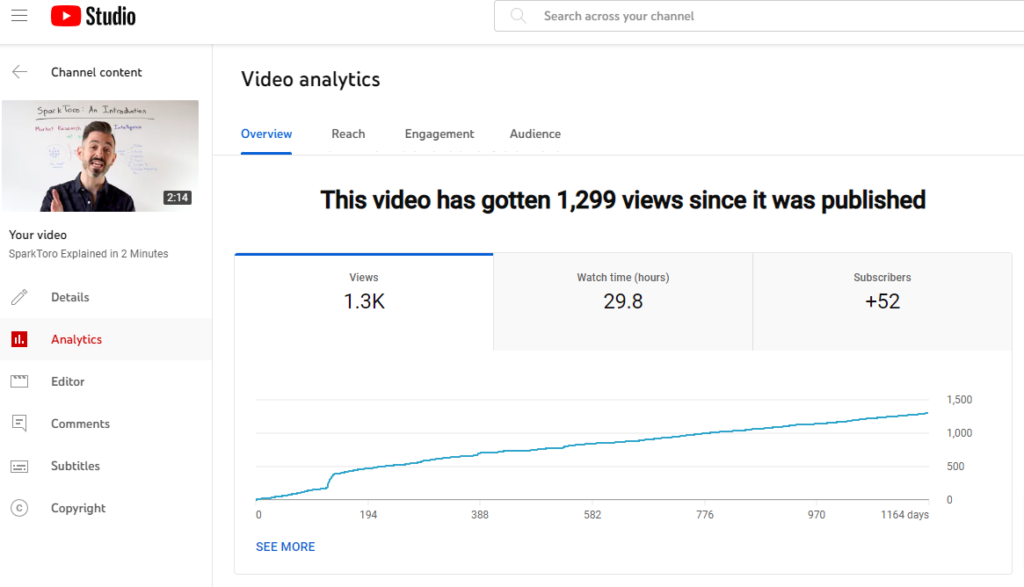Howdy SparkToro fans and welcome to the first edition of a new series we’re experimenting with—short, whiteboard style explainer videos. This inaugural video covers a concept that’s crucial to the future of marketing: measurement vs. attribution.
For the last 20 years, we’ve lived in the golden age of attribution. Measuring the kinds of metrics I talk about in the video: views, impressions, followers, and subscribers were long deemed “vanity metrics” in comparison to the “money metrics” of attribution. But, as we’ll talk about next week… that golden age is likely coming to an end.
Video Transcript:
Howdy folks, and welcome to our first ever 5-minute whiteboard. Today, I’m gonna talk about measurement versus attribution.
Very important concept for every marketer, every CEO, everyone who’s building a business to understand and invest in. So measurement, OK. Let’s imagine that I am selling the secret ingredient to making incredible Cacio e Pepe. Cacio e Pepe: the classic Roman recipe. It’s like pasta in a in a cheese sauce, specifically with pecorino and and black pepper.

Rand’s homemade cacio e pepe, with perfect consistency thanks to the secret ingredient
But, to make perfect Cacio e Pepe, you can make it normally, but there’s this sodium citrate ingredient that makes it incredible. So let’s imagine that I am selling sodium citrate, it’s e-commerce, direct-to-consumer play, I’m selling it online. I put up a video on YouTube, and the video does very well because I’m sharing this secret that and maybe I’m cooking, and I’m showing people, right, it gets lots and lots of views and engagement.
I can measure video views and watch time, right? Subscribers, I can measure impressions and click through rate. YouTube will give me all of these things. They’ve historically been called “vanity metrics” by a lot of people in the marketing universe because what they don’t do is tell you exactly how many people who watch the video converted or eventually converted to a sale, right? So I can see lift in things like sure, yeah go for it.

An example of YouTube’s analytics for video creators
Website traffic I can see my conversions, of course. I can measure that on my website. I can measure my conversion rate rate lift, maybe after the video comes out over the next thirty days or sixty days as the video views are ticking up so too are my sales, so too is my conversion rate. But do I know for certain that the video was the thing that did.
It could have been anything else. Absolutely, it could have.
Attribution is the concept of being able to say, oh, I ran a pre roll ad on YouTube and Google’s network of data right tells me that when I ran this by the secret ingredient to make perfect that I get not only impression and view metrics of how many people saw that ad, but Google will tell me direct conversions, right, people who came to my website and bought and how many of them saw the ad and even view through conversion These are folks who saw the advertisement on YouTube or or on somebody else’s website through a YouTube video. And then later, could be ninety days later, could be two hundred days later, they came to the website and they purchased.
Now view through conversions are getting tougher because cookie windows are changing Google’s whole mechanism around cookies is changing, you know, Chrome and Safari and other folks are making these changes. But this is the concept, the core concept behind attribution and attribution, this has been has been the model. Right? This has been the way that marketers invest a huge portion of their dollars because they can prove that if they spend more, they get more conversions.
Right? They can prove the attribution on each of these. Here’s the rub. These view through conversions, which are responsible for a ton of the sales that come from attribution, these might not all be real.
I mean, they’re all real, but they might have happened anyway.
Imagine you see this pre-roll ad, you are already going to buy the secret ingredient to Cacio e Pepe, but Google targeted you with this advertising because it knew you had searched for pasta related things before and maybe you’d even searched for the brand name of this secret ingredient. And so now They’re claiming credit for this. This is the challenge around attribution, and I’ll talk more about it maybe next week, but I’m a strong believer in measurement for the future. I think attribution is gonna get harder and harder for a ton of marketers.

Management likes provable results > high ROI, but difficult-to-prove results. Hence, even when Google (for example) doesn’t live up to its promises about where and how ads will be shown, brands continue to invest. The culture of attribution addiction is strong, and it’s going to be a long while before leadership teams are ready to embrace the hard-to-prove channels that often drive the best results.
Look forward to your feedback about this new content format for SparkToro!